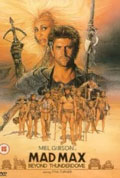
Directed by
George Miller / George Ogilvie
107 minutes
Rated M
Reviewed by
Bernard Hemingway

Mad Max Beyond Thunderdome
The third in the Mad Max series not only continues the trend towards larger budgets but skews into Spielbergian adventure/comedy territory with more of a juvenile multiplex appeal than the previous films – the rampant homoeroticism of Mad Max 2 is gone, replaced by the heterosexually-provocative presence of Tina Turner, Max is more of a good guy than his earlier bitter and twisted incarnations and a tribe of ‘lost kids’ J.M. Barrie-style features prominently. Miller’s burgeoning interest in pigs, seen in a small way in the previous film, also gets increased exposure (they remain likeably dunderheaded despite the woeful attempt to portray them as flesh-eating monsters) and Mel Gibson finally settles into a recognisable Australian accent.
The film is visually much more stylish than its earnest predecessor thanks to Graham 'Grace' Walker‘s lavish production design but it is the least adventurous or innovative of the three films, reworking much of Mad Max 2 and even revisiting that film’s famous chase sequence, although not as impressively, and it is deservedly regarded as the weakest edition in the saga.
FYI: Co-director George Ogilvie, who had worked for Miller’s television company, is generally credited with the preparatory rehearsals. Miller’s partner in that company and co-producer on the first two films, Byron Kennedy, died in a helicopter crash in 1983.
Want something different?





